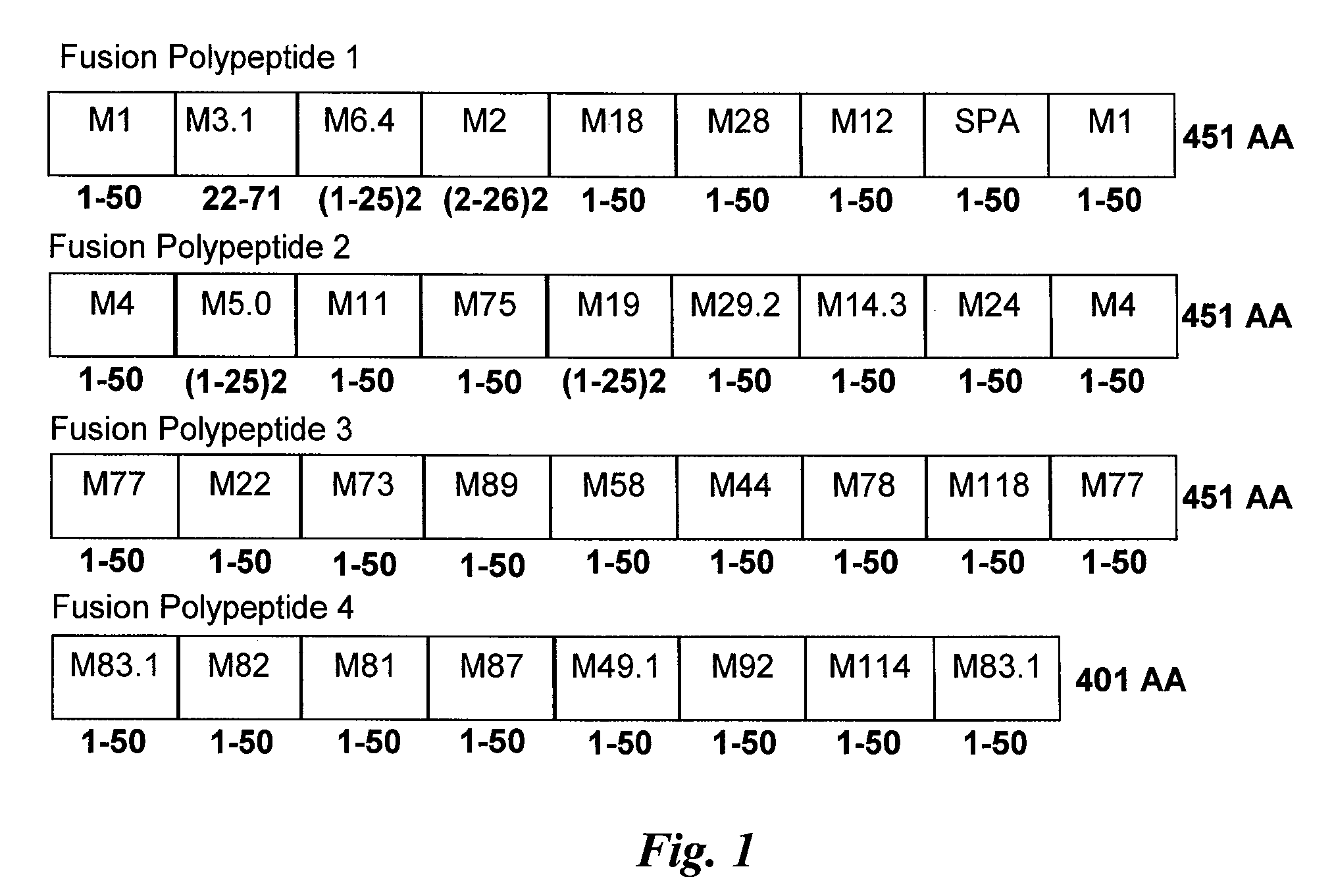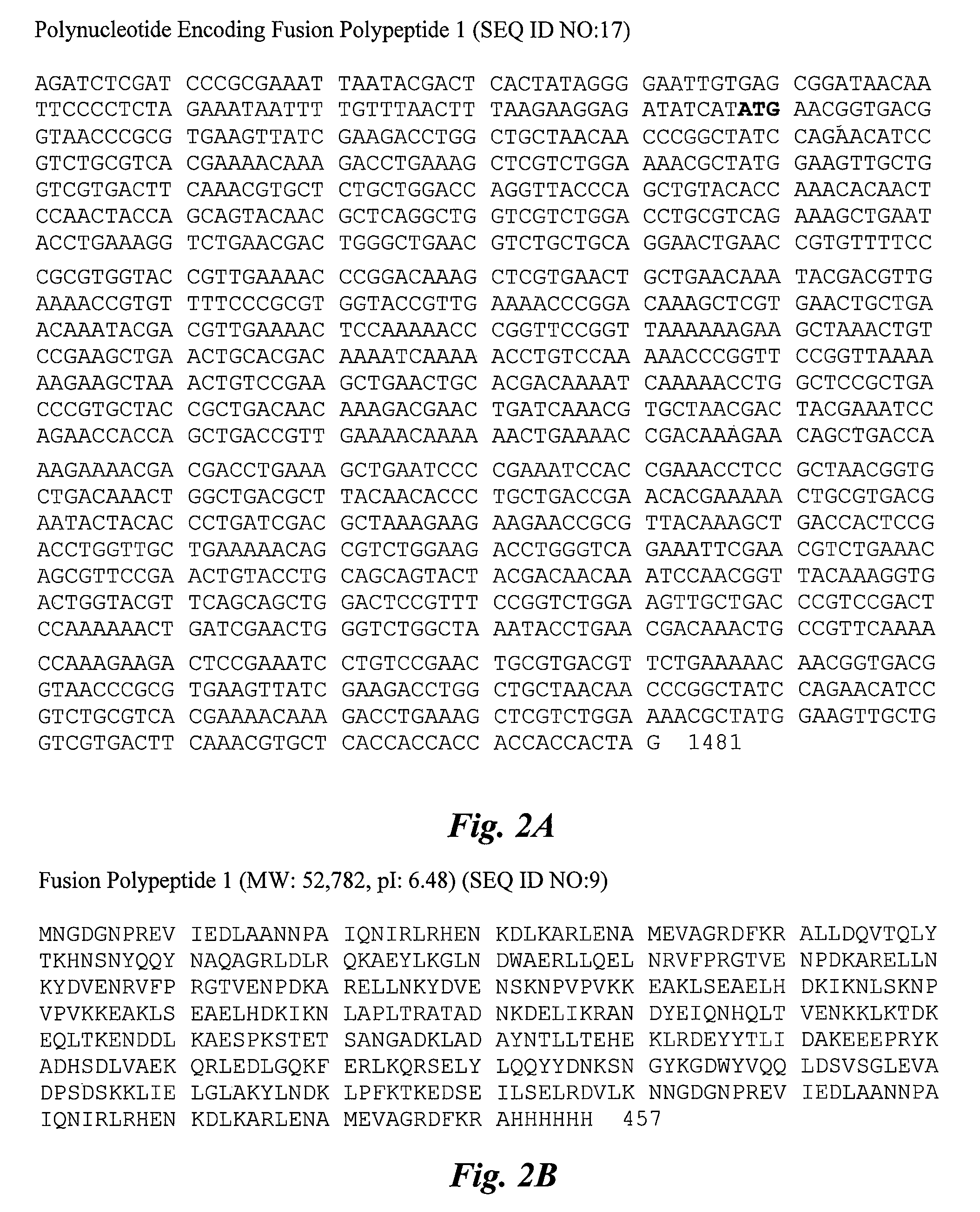Group A Streptococcus multivalent vaccine
a vaccine and streptococcus technology, applied in the field of grouping a streptococcus multivalent vaccine, can solve the problem that the 26-valent vaccine does not provide sufficient protection against infection
- Summary
- Abstract
- Description
- Claims
- Application Information
AI Technical Summary
Benefits of technology
Problems solved by technology
Method used
Image
Examples
example 1
[0199]This example describes characterization of a GAS antigen expressed by and present on the cell surface of GAS serotype 4.
[0200]The potential protective efficacy of the 30-valent vaccine described below and herein was enhanced by the discovery of opsonic epitopes within the N-terminus of the protein Arp4, which is a component of protein 2. Arp4 was previously shown to bind IgA but was not required for virulence or resistance to phagocytosis (see, e.g., Husmann et al., Infect. Immun. 63:345-348 (1995)). The most recent epidemiologic studies found that Type 4 streptococcal infections account for up to 9% of all GAS infections. To detect opsonic epitopes within the N-terminus of Arp4 (M4), rabbit antisera were raised against (1) a synthetic peptide representing the N-terminal 30 amino acids of the protein, (2) a recombinant fusion protein containing 50 amino-terminal residues of Arp4 as well as 5 other M peptides, or (3) the intact recombinant Arp4 prot...
example 2
Design and Construction of Multivalent GAS Peptide Compositions
[0201]This example describes selection of GAS serotypes from which M proteins immunogenic fragments would be selected and describes construction of fusion polypeptides comprising these immunogenic fragments.
[0202]M peptides were selected from serotypes of GAS based on the epidemiology of 1) pharyngitis in pediatric subjects in North America (see, e.g.; Shulman et al., Clin. Infect. Dis. 2009, supra); (2) invasive GAS infections (see, e.g., Active Bacterial Core Surveillance of the Emerging Infections Program Network, supported by the Centers for Disease Control and Prevention) (see, e.g., O'Loughlin et al., supra); and (3) invasive infections in Europe (for example, as reported by the StrepEuro consortium, see Luca-Harari et al., supra). Also included in the 30-valent vaccine composition were M peptides from serotypes of GAS that are currently or have been historically considered “rheumatogenic” (see, e.g., Shulman et al...
example 3
Immunogenicity of Multivalent GAS Peptide Compositions
[0210]This example describes studies performed to characterize the immunological properties of the multivalent immunogenic compositions.
[0211]Vaccine formulation and immunization of rabbits. The four vaccine fusion polypeptides were mixed in equimolar amounts and adsorbed to alum (REHYDRAGEL®, low viscosity, Reheis, Inc., Berkeley Heights, N.J.). Vaccines were formulated so that each 0.5 ml dose contained 200 μg, 400 μg, 800 or 1000 μg of protein and approximately equal amounts of alum by weight. Groups of three New Zealand white rabbits were immunized with the four vaccine doses via the intramuscular route at 0, 4, and 8 weeks according to described protocols (see, e.g., Dale, Vaccine 17:193-200 (1999)). Serum was obtained prior to the first injection and two weeks after the final injection.
[0212]Detection of type-specific antibodies. ELISAs were performed using preimmune and immune rabbit sera by methods previously described (s...
PUM
| Property | Measurement | Unit |
|---|---|---|
| pH | aaaaa | aaaaa |
| dissociation constant KD | aaaaa | aaaaa |
| time | aaaaa | aaaaa |
Abstract
Description
Claims
Application Information
 Login to View More
Login to View More - R&D
- Intellectual Property
- Life Sciences
- Materials
- Tech Scout
- Unparalleled Data Quality
- Higher Quality Content
- 60% Fewer Hallucinations
Browse by: Latest US Patents, China's latest patents, Technical Efficacy Thesaurus, Application Domain, Technology Topic, Popular Technical Reports.
© 2025 PatSnap. All rights reserved.Legal|Privacy policy|Modern Slavery Act Transparency Statement|Sitemap|About US| Contact US: help@patsnap.com



